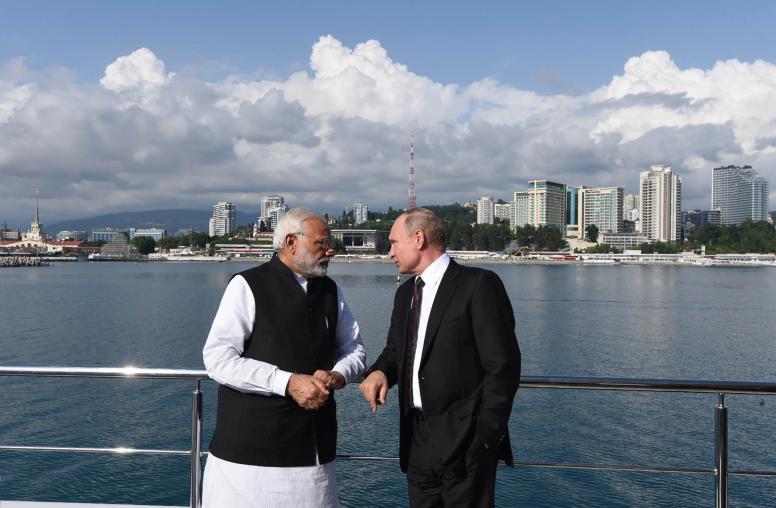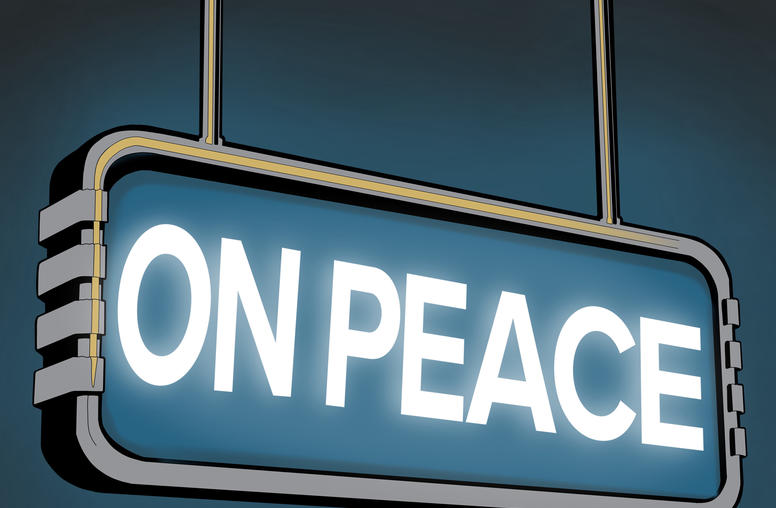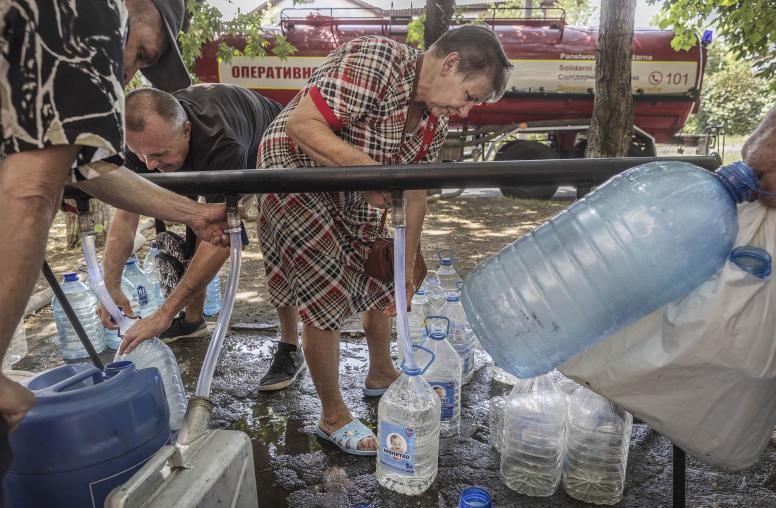Another Way to Help Ukraine: Prepare Now for a Peace Process
If Ukraine opts for negotiations, Europe and the United States need to be ready to join.
Three months of Russia’s savagery against Ukraine have left little space in current policy discussions for considering a peace process. President Biden vows to strengthen Ukraine before any negotiations by providing more arms and funds, and tougher sanctions on Russia. Alongside that vital support for Ukraine’s defense, it is important to develop other ways to help Ukraine end bloodshed and protect its future. One track of policy should be preparation now for negotiations if that opportunity emerges. Crucial elements for a viable peace process already are visible: direct U.S. and European Union participation in specific talks, and a peacekeeping mission to prevent Russia’s consolidation of control over contested Ukrainian territory.

Negotiations: Under What Conditions?
Western governments are unified in declaring that any negotiation will be done by the Ukrainians based on their own needs and on their own timetable. Beyond that principle, the world has heard little public discussion of peacemaking ideas since March, when Russian-Ukrainian negotiations in Turkey ended without result. Peace proposals outlined by Poland and Italy have not won broad support even within the European Union. The Russian atrocities at Bucha and elsewhere in Ukraine have significantly dampened interest in negotiations. In early May, Ukrainian President Volodymyr Zelenskyy said Russia would need to pull its troops back “behind the lines it held before February 24,” before any negotiations can happen. As combat has shifted toward a war of attrition that could offer significant advantages to Russia’s larger forces, U.S. and European politicians and commentators are divided over when it could make sense for Ukraine to consider peace talks.
Skeptics of any near-term negotiation fear that a cease-fire and talks would represent appeasement of Russia, letting it keep the 20 percent of Ukraine that it has seized militarily. This view holds that talks should be postponed until Russia is weakened or ideally defeated. Hazards of this approach include the danger that the costs of extended war could push Ukraine’s economy into collapse and erode public support for the war in Europe and North America. A separate risk is the deep uncertainty that Ukraine can force Russia out of the lands it has seized. Indeed, Russia could solidify its military control in eastern Ukraine and then offer a unilateral cease-fire, creating a Cold War-style “line of contact” and a long-term, grinding war with devastating consequences.
The other camp notes those heightened risks of a prolonged war and suggests that negotiating with Russia sooner can avoid worse political, economic and human losses. Former Secretary of State Henry Kissinger urged on May 23 that negotiations “need to begin in the next two months or so.” This approach carries two risks: It would not resolve underlying conflicts over Ukraine’s independence and territorial integrity, or over European security issues, leaving them to fester, risking continued violence. Also, it could wind up conceding significant gains to an armed aggressor, undermining the global effort to sustain any kind of rules-based order.
The Imperative to Prepare
Why, then, prepare for peace talks now? A first reason is the unpredictability of war, which dictates that the advantageous moment for a shift to negotiations could appear without warning — and could disappear just as suddenly. A full strategy of support for Ukraine requires that its supporters help to prepare it to make the most of negotiations if and when Ukraine has the opportunity to benefit from them.
Thus, even as Western democracies rush arms and assistance to Ukraine, strategic preparation now for an eventual peace process can lead to a broader set of choices, with a better chance of success, as Ukraine’s government calculates its options. That preparation also positions Ukraine and its allies to more quickly halt bloodshed whenever conditions emerge for negotiations.
Russia and Ukraine currently have nothing to offer each other that could support peace talks to halt the war. Thus, a starting point in strategically preparing for talks is to envision a structure for negotiations that offers each side the chance to bargain for something it wants. In many wars — and assuredly in this one — enticing an aggressive belligerent like Russia into a peace process may require expanding the field for negotiations beyond the issues that triggered the hostilities.
Two Essentials for a Peace Process
A way to draw Putin into eventual peace talks — and into negotiating over his control of Ukrainian territory — will be to offer him the chance to bargain directly with the United States over his broader complaints. Essentially, this will mean a negotiation over what Putin thinks is Russia’s unfair marginalization as a great power and the security and economic threats to Russia of expanding NATO and EU strategic influence. Indeed, some have argued (against most evidence) that a root of the conflict lies not in Ukraine but in the Russian desire for a reform of the European security architecture. A viable peace process that creates a path for Ukraine to seek a recovery of territory seized by Russian arms will need to include these two elements:
- Broaden a peace process beyond simply Russia-Ukraine negotiations to include a separate negotiation that includes Europe and NATO. To encourage Russia to make difficult concessions to Ukraine (notably a withdrawal from territories Russia has seized in war), the peace process should proceed simultaneously on three levels. Russia-Ukraine talks would address their bilateral disputes. Second, Russian talks with the European Union and Ukraine would aim to reset their relations (disrupted since 2014) and seek agreement on economic and security arrangements for countries, like Ukraine, that lie between Russia and the EU zone. Given the failures of earlier diplomacy, involving the Organization for Security and Cooperation in Europe, to resolve the Russia-Ukraine crisis, it will be necessary to reform that organization and re-establish it as a long-term confidence-building measure to prevent future regional conflicts. Finally, Russia talks with NATO and the United States would take up issues of strategic stability and the U.S.-Russian relationship in the world order. While some would argue that broadening the negotiations would just reward Putin for his use of force, only this full combination of negotiations, equal and interlocking, might entice him into making concessions to Ukraine.
- Keep the status of Ukrainian territories seized by Russia undetermined pending the completion of negotiations. To avoid the risk of Russia consolidating its control over parts of Ukraine it has captured, a peace process could establish that space as a buffer zone under U.N. or other third-party control until negotiations are complete. This would require a peacekeeping mission of some kind in that zone. This step also would serve as a confidence-building measure until a negotiated solution can be reached. The longer the war goes on, the more opportunity Russia will have to cement its hold on the substantial swaths of territory Ukraine has lost already with “facts on the ground,” and to cover up war crimes there. Internationalizing the negotiations and inserting peacekeepers could win time and space to achieve a better outcome through non-military means.
As in any war, the lengthening of the conflict, the losses on each side and the political entrenchment of belligerents’ demands can make it more difficult, or even politically dangerous, for leaders to make concessions. The better chance of winning concessions will come from a broad process that can address the many issues in dispute, including many that risk hardening in place a new Cold War. These will include nuclear arms control, cyber warfare, Russia’s role in distant conflict zones, and mutual accusations by Russia and the West that each is interfering in the other’s political systems. While Ukraine’s territorial integrity and status seem like the biggest obstacles to a peace deal, issues such as the investigation of war crimes, accountability for rebuilding Ukraine and Russia’s future role in the region may prove more difficult.
Critically, the European Union and Russia will have to reset their relationship, which collapsed after Russia’s 2014 invasion of Crimea. Europe’s sanctions on Russia and divestment from dependency on Russian oil and gas pose long-term costs for both sides. Enticing Putin to offer concessions to Ukraine might be achieved by creating a broader zone for negotiating his complaints against Europe, the United States and NATO. The key to all three negotiations is to ensure that they include regional neighbors and that all sides see a chance to make political and economic gains at different tables while also creating disincentives for prolonging the war. The question is not whether to talk to the Russians or not, it’s what to talk to them about — and when.



